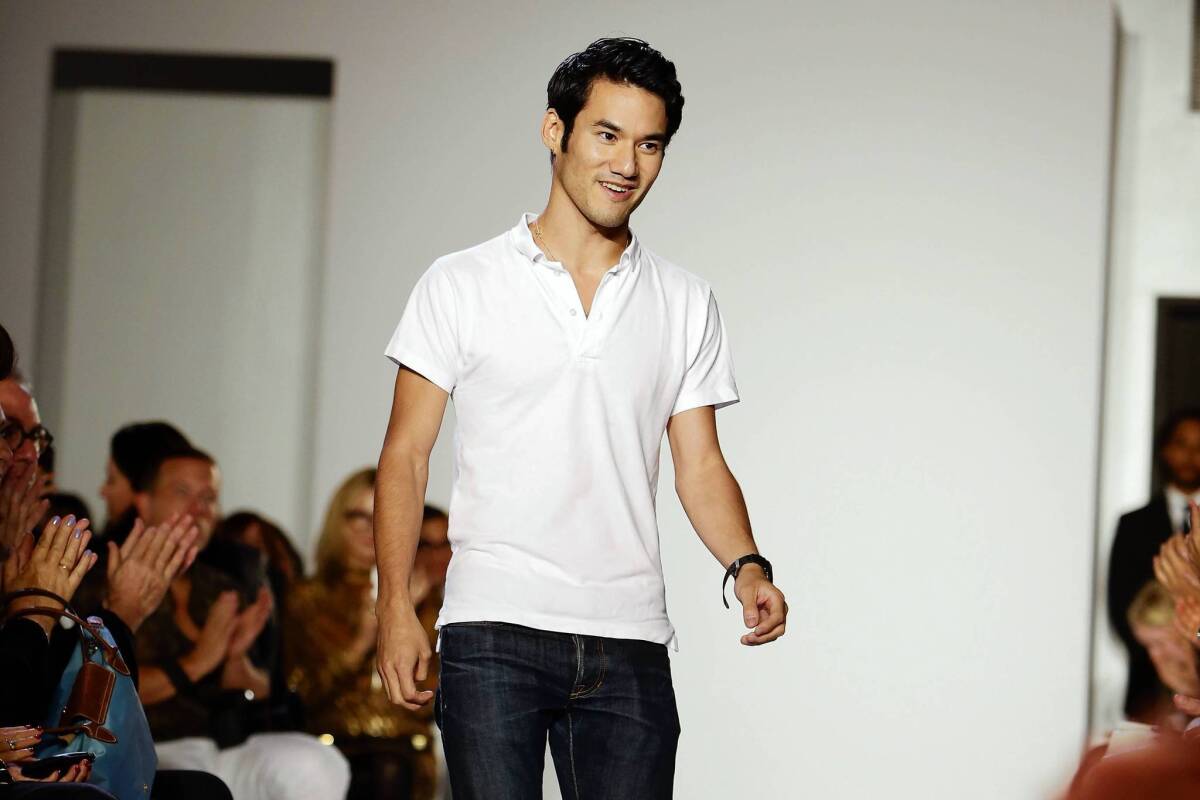Joseph Altuzarra’s stars are in alignment

Over the past few weeks, the stars have been aligning for designer Joseph Altuzarra.
First came news that Kering, the European luxury conglomerate that owns Gucci Group and built Stella McCartney and Alexander McQueen into global brands, bought a minority stake in his company. Then, the designer’s spring-summer 2014 collection, inspired by Japanese boro workwear, emerged as the hit of New York Fashion Week, with every major American department store buyer naming it among the week’s best.
Days later Altuzarra, 30, a self-described television addict, took the spotlight in L.A., co-hosting a kick-off party for Emmys week last Sunday and designing the dark gray suede interior of the green room where stars will hang out backstage during the awards show tonight.
Between work obligations (he had his lightbox shipped from New York so he could continue to design his next collection), he’s managed a few fun L.A. outings, going to Komodo on Pico Boulevard for fusion burritos (a tip from Food Network’s “The Great Food Truck Race”), to H.D. Buttercup to shop housewares (another favorite show is Bravo’s “Interior Therapy”) and to vintage store The Way We Wore to do fabric research.
There’s the possibility, of course, that Altuzarra will be dressing someone for the Emmys red carpet, although he isn’t getting his hopes up. “As a brand, we don’t do a lot of awards stuff, because we don’t do a lot of long dresses,” he said over breakfast Tuesday. “The clothing I like to design is much more the clothing you would wear on the street. Actresses — and I understand it — they want one kind of dress, something very corseted, where they feel super held in, or something that’s got a pouf. There’s a style of dress and it’s not one that feels very me.”
What Altuzarra stands for instead is utiliarian sportswear spun into sultry luxury. Not that he hasn’t gotten his fair share of celebrity attention. His signature silhouettes, powerfully sexy slit skirts and slit dresses, have been worn by Kate Upton, Nicole Kidman, Cate Blanchett and fashion editor Carine Roitfeld, an Altuzarra supporter since the beginning.
Born to a Chinese-American mother and a French-Basque father, Altuzarra grew up in Paris. He studied art history at Swarthmore, spending a semester at Pomona College, which he liked so much, he tried to transfer. Although Altuzarra has no formal fashion training, he had stints in New York at Marc Jacobs, Proenza Schouler and, most notably, in Paris as Givenchy designer Riccardo Tisci’s first assistant before launching his namesake collection in 2008. On the journey to discover his signature look, his collections veered from grunge glam to coin-dripping exoticism, but he never lost sight of his vision of creating a brand with mature sex appeal.
“As I developed my style, I realized what is important today, especially for young designers, is to own something,” he says.
Vogue magazine and the Council of Fashion Desigers of America have helped him along the way. In 2011, he won the CFDA/Vogue Fashion Fund Award, followed in 2012 by the CFDA Swarovksi Award for Women’s Wear Design.
“There is this incredible curiosity about new talent in New York, which is a large part of why I moved there,” he says. “In Italy or France, there’s a rejection or fear of youth. But the U.S. has learned to embrace it and they’ve grown strong businesses from the ground up, like Rag & Bone and Proenza Schouler. The retailers are supportive, too. Barneys bought my first collection. In a lot of ways, retailers will give you the tough love that editors won’t, and it helps you grow.”
In the spring 2014 collection, he showed his signature pencil skirts in menswear-inspired ticking stripe silk or indigo patchwork. “I liked the idea of doing something that felt different but also familiar,” he says. “The whole concept came from this type of Japansese technique for clothing called boro, which I had been thinking about for a long time, because I love the idea of beauty and humility. Japanese fisherman would have one piece of cotton clothing over their lifetime that would be mended, and the mending would become ornamentation, but not purposefully. Examples of boro, which dates to the early 19th century are hard to find, but we found one, which we used for print development. The prints are on silk, but they read as a luxe alternative to denim.”
Next up, with help from his new investors at Kering, Altuzarra is working on his first pre-fall collection and launching accessories. “Obviously financial support is important to grow any brand,” he says. “But what was so great about this deal is that they also have an infrastructure and expertise that’s invaluable.”







